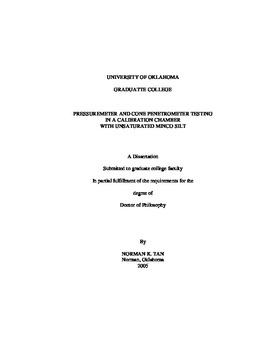| dc.contributor.advisor | Miller, Gerald A., | en_US |
| dc.contributor.author | Tan, Norman K. | en_US |
| dc.date.accessioned | 2013-08-16T12:19:48Z | |
| dc.date.available | 2013-08-16T12:19:48Z | |
| dc.date.issued | 2005 | en_US |
| dc.identifier.uri | https://hdl.handle.net/11244/861 | |
| dc.description.abstract | The focus of this study is to investigate the influence of matric suction (&psgr; ) on PMT and CPT results by conducting miniature pressuremeter (MPMT) and miniature cone penetrometer (MCPT) testing in a calibration chamber with unsaturated Minco Silt soil beds at the University of Oklahoma. Test beds were built to encompass a range of matric suction ranging from 15 kPa to 75 kPa in order to study the influence of &psgr; on the MPMT and MCPT results. The &psgr; was determined directly via tensiometers and indirectly by using the soil-water characteristic curve and water content (w) of samples. In addition to &psgr; the influence of dry unit weight (gamma d) of the soil beds on the MPMT and MCPT results were studied. The gamma d and w of the soil beds were determine by collecting small tube samples throughout the soil beds. The influence of net normal stress (sigman) on MPMT results was also examined in this study by compressing the soil beds at three different sigman. The MPMT and MCPT results were evaluated using the statistical analysis and cavity expansion equations for unsaturated soils developed by Muraleetharan et al. (1998). The statistical analysis of the test data reveals that the influence of soil processing methods, gamma d, w, &psgr; , volumetric water content (theta) and sigma n on MPMT and MCPT results are significant. Empirical correlations that correlate the parameters with MPMT and MCPT results were also developed. The analysis of the test data with cavity expansion equations for unsaturated soil shows that the volumetric strain of the soil in the zone of influence decreases as matric suction increases. In this study, the cavity expansion analysis revealed that during the expansion of the cavity, the soil within the plastic zone of influence for pre-bored MPMT underwent compression; meanwhile for MCPT the soil underwent dilation. | en_US |
| dc.description.abstract | The pressuremeter test (PMT) and cone penetrometer test (CPT) are becoming popular instruments for subsurface exploration. The PMT is an excellent test to determine the mechanical behavior of the soil and is one of the few geotechnical in situ investigation methods that gives a stress-strain relationship of soil, while the CPT is an excellent in situ test that gives a continuous subsurface profile rapidly. It is common for geotechnical engineers to encounter a zone of unsaturated soil prior to saturated soils below the groundwater table. In the arid regions of the world, the ground water table can be at substantial depth. However, many of the theories and methods of analysis of PMT and CPT are largely based on assumptions appropriate for saturated and dry soils. Over the last couple of decades it has been well accepted that the behavior of unsaturated soil is different from the completely saturated or dry soil. Therefore, there exists a need for methods to interpret PMT and CPT data from unsaturated soil. | en_US |
| dc.format.extent | xviii, 198 leaves : | en_US |
| dc.subject | Soil mechanics. | en_US |
| dc.subject | Engineering, Civil. | en_US |
| dc.subject | Penetrometers | en_US |
| dc.subject | Zone of aeration. | en_US |
| dc.title | Pressuremeter and cone penetrometer testing in a calibration chamber with unsaturated Minco Silt. | en_US |
| dc.type | Thesis | en_US |
| dc.thesis.degree | Ph.D. | en_US |
| dc.thesis.degreeDiscipline | School of Civil Engineering and Environmental Science | en_US |
| dc.note | Source: Dissertation Abstracts International, Volume: 66-02, Section: B, page: 1056. | en_US |
| dc.note | Adviser: Gerald A. Miller. | en_US |
| ou.identifier | (UMI)AAI3163317 | en_US |
| ou.group | College of Engineering::School of Civil Engineering and Environmental Science | |
